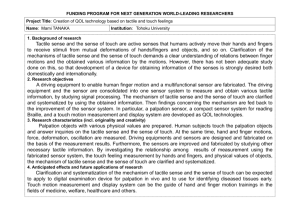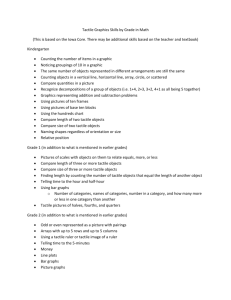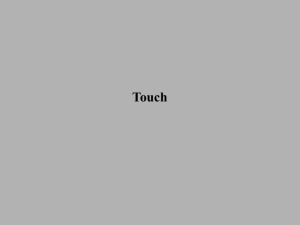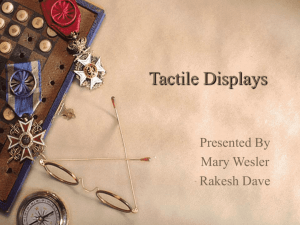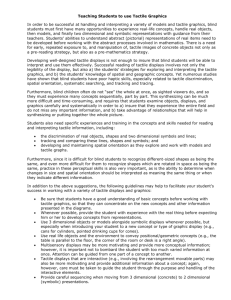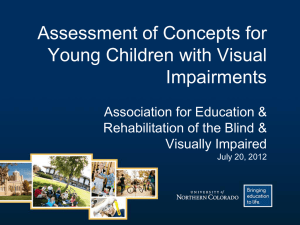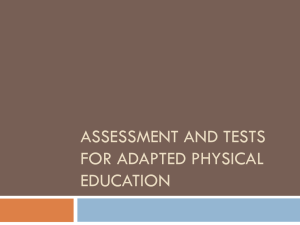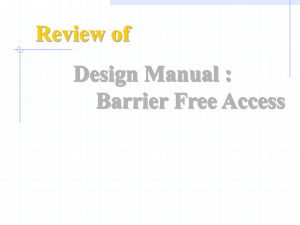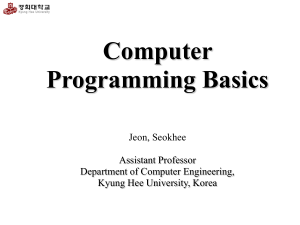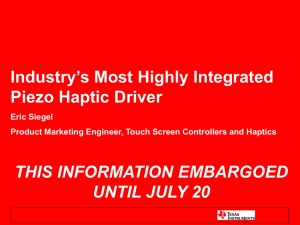Haptic Perception and Devices
advertisement
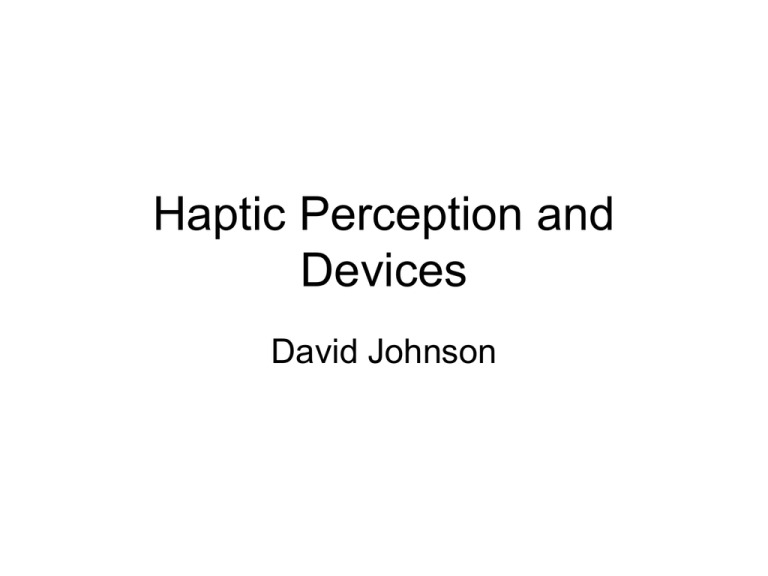
Haptic Perception and Devices David Johnson What is Haptics? • adj. Of or relating to the sense of touch; tactile. [Greek haptikos, from haptesthai, to grasp, touch.] – Haptics involves both proprioceptive and tactile senses, in concert with other senses. • adj. The science of applying touch (tactile) sensation and control to interaction with computer applications. The Sense of Touch • Everyday Tasks – Dialing a phone – Playing a guitar or piano – Finding a light switch – Using a mouse • Touch is complex: tying a shoelace • Only bi-directional communication channel – both input & output Why is Touch Important? • Touch-tone phone – Rich tactile cues – Can be done without looking – Effortless • PC calculator – No tactile cues – Only visual feedback – Painstaking Tactile Perception • Provides information about our environment – e.g. hot, cold, smooth, rough • Provides feedback – e.g. when trying to lift an object, press buttons, etc. • Difficulties if no feedback? Haptics Human skin Surface of average sized adult human: 1.8 m2 (1000 times that of retina) Weight: 5 kg Total number of axons: 1.1*106 Retina: 106 axons, Cochlea: 6*104 axons Haptics and Vision Information capacity (bits/sec) Temporal acuity Fingertip 102 5 ms Ear 104 0.01 ms Eye 106-109 25 ms Peripheral Pathways of Touch • Mechanoreceptors - pressure, texture, vibration • • Proprioceptors - body position Nocioceptors – Two pathways for pain • • • one fast pathway for sharp pain, one slow pathway for dull pain Thermoreceptors Four Receptor Types a) Merkel Disks -- constant sources of stimulation over a small area, such as if you were carrying a pebble b) Meissner Corpuscles -respond best to active touch involved in object exploration c) Ruffini Endings -- constant stimulation over a larger area - also detects skin stretch d) Pacinian Corpuscles -extremely sensitive over a large receptive field -- blow gently on the palm of your hand Functional characteristics of Skin Mechanoreceptors: Receptive field size (I = small, II = large) and adaptation rate (FA = fast adapting, SA = slow adapting) FA I SA I FA II SA II Receptors Meissner’s Corpuscle Merkel Cell Complex Pacinian Corpuscle Receptive Field Intensity and Time Course of Neural Signal (adaptation) Neural Spike train Stimulus Kandel et. al., 2000 Ruffini Ending Receptive Field The two-point threshold for any part of the body is determined by the size of the receptive fields and the extent of overlap Proprioception • All muscles have nerve fibers which detect the amount the muscle is stretched • All joints have fibers which detect the relative position of each bone • Together these allow you to determine the position of every part of your body. [Green] Proprioception Includes The Vestibular Sense Ocular Motor [Green] Haptics Haptic Interfaces • Fully duplex channel. You can both transmit and receive information simultaneously. • Requires very high refresh rates of approx. 1000 Hz for realistic feel. • Requires very high spatial resolution. – On smooth glass surface, dot of height 1-3 µm and diameter of 550 µm can be detected by the fingertip (Johansson & LaMotte, 1983) Tactile Technologies • Tactile information is produced by perturbing the skin – Pins or other mechanical vibrating elements - either alone or in an array, as in devices for Braille display • typically used for fingertip stimulation – Air jets blow to produce a disturbance – Cushions of air can be inflated or deflated to vary pressure on skin – Electrical stimulation - low levels of current provide a localized tingling sensation • Typically used in gloves, or for larger body areas Laterotactile • Induce sensations of indent from lateral movement of skin Vibrotactile Electrotactile Servomotor mechanical Tactile Vest Force-Feedback Technologies • Kinesthetic (relating to the feeling of motion) info is produced by exerting mechanical forces – Haptic devices movie MPB Freedom7 and Cubic CyberForce [Chang] 6DOF Delta Magnetic Levitation • • • • CMU Very high fidelity Small workspace movie Exoskeleton • 5DOF Rutgers Hand Master • Pneumatic Foot Haptics (locomotion interface) Omni-directional treadmill Foot-based interfaces Sarcos Biport Iwata’s GaitMaster Whole-Body Haptics Sarcos Treadport II CirculaFloor • Moving floor tiles • An example of “encountered haptics” Discussion • Mechanical aspects are more daunting than for other VR technologies • Must handle gross positioning (proprioception) and fine detail (tactile) • Burgeoning area – 10 years ago, 20 papers a year – Now, 1000’s.
